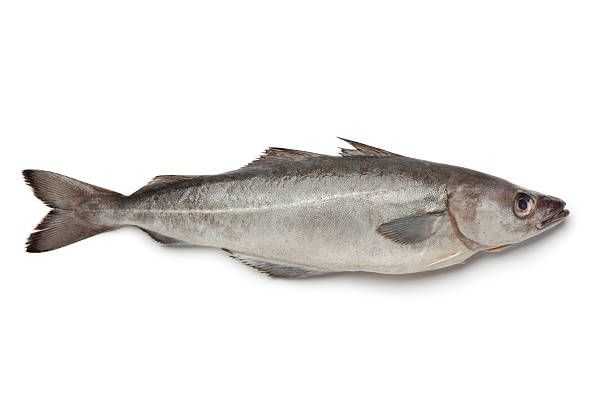Pollock

Species Details
Pollachius pollachius
Gadidae
Gadiformes
Offshore, Nearshore
20 - 35 lbs.
24" - 42"
Pollock (Pollachius pollachius) Fish Description
The Pollock is a fish also known as the coalfish, and has a subtle signature feature: the length of its jaw. To tell the difference between the Pollock and its cousin, the former has a stronger underbite. Another is the color. The Pollock has a silvery lateral line and right beneath it, it has a sort of greenish-black hue. Whereas, the Atlantic Pollack has one in grayish gold, the pollock also has straighter pectoral fins whereas its cousin has a slight kink. It also has relatively smaller eyes.
The pollock also has a chin barbel that functions as a “whisker” in cats. It uses the barbel to find its food. As it grows, the pollock's color turns brownish-gray on top but greenish at the bottom.
Diet
The Pollocks are carnivorous. They feast on smaller fish such as smelt and capelin. However, as they grow bigger, they are also capable of eating squid. When looking for food, Pollocks are often seen swimming near salmon farms, eating leftover salmon feeds. They also feed on planktonic crustaceans.
Size
An adult pollock size ranges from 40 to 47 inches. However, some have reported that individual pollock catches have ranged up to 51 inches. The pollock reaches maturity after 4-9 years and lives up to 16-20 years. Commonly, male pollocks are larger than female pollocks.
Interesting Facts
Because the Pollock is a bottom feeder, its flesh doesn't look as impressive as the Atlantic Pollack. Its dark-colored flesh gives it a bad reputation that it doesn't feed and therefore, poor quality. In reality, some commercial areas use Pollock as a substitution for Salmon, especially in cat food. Coalfish is also quite popular in Norway where it is sold as “seelach” (literally, Sea Salmon). However, the existing premise that “whiter fish flesh" is better tasting has made the Pollock considerably cheaper than its cousin.
In the British Isles, the Pollock is also commonly known as a Coley.
Pollocks are sensitive to temperature and to the tides. Otherwise, they often stay in the depths unless they detect vibrations.
Some say that speed isn’t their strongest asset. Rather, it’s their strength. Some say that once you catch a Pollock, prepare to struggle. It’s also why experienced Pollock anglers say bring good footgear. You’re going to need the ankle support and grip. Otherwise, you��’ll just be dragged along by the fish.
Pollock – Fishing Techniques: How to Fish for a Pollock
When fishing for a Pollock, one of the things you should bring are sturdy fishing boots. Find boots that give you good ankle support and weigh you down so you don’t get dragged down with the fish. The Pollock are known to snatch and drag their prey to the depths. Best you don’t become part of their prey too.
For the baits, the best kind of baits seen to work are either Sand Eel imitations or Black Minnow imitations. Weedless fishing works well too and even the color can affect your catching rate.
Another thing to take note is the time you go fishing. The best time to go fishing would either be early morning or evening.
Make sure to travel light also when going. Since Pollock like rocky areas, you’ll need to scale a few cliffs and ledges every now and then to get to a good spot.
As for setting up your fishing spot, check the tides. The more the tide, that works better for you. However, adjust the weight of the lure once you find a place with a high tide to make sure your lure stays connected. From there, do a bit of jigging as you lure it back to either the shore or kayak. If you’re on a kayak, the recommended depth is 20 meters. For those fishing from shore, you’ll have to go a little deeper or wait for the tide to rise to an all-time high to get them close.
Habitat
Pollock, and especially the juveniles, like rocky areas. The young pollock often hide near algae and lurks among shallow areas. Once matured, the adult pollock head back to the deeper parts of the ocean. They are quite picky with the temperature and depth. They are usually found in depths of 100 to 400 feet. They are most commonly found in Alaska in the Northern Pacific and the Bering Sea.







